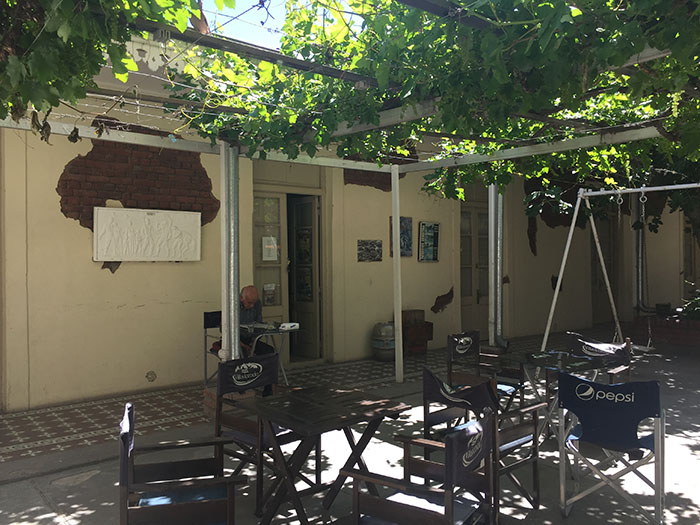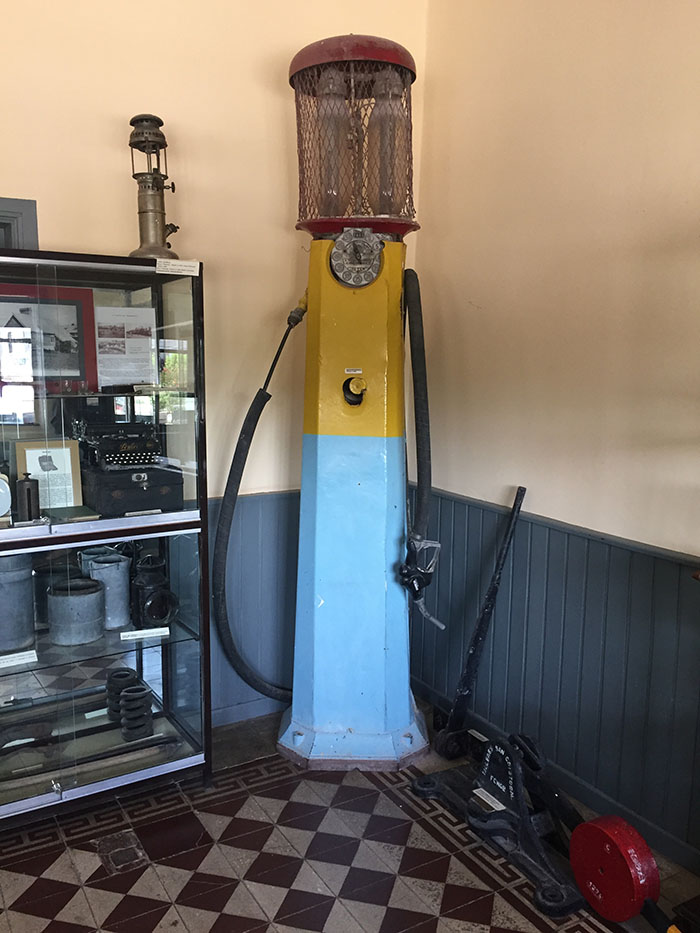Saturday 19 November, 2016; Trelew – Los Altares
We had breakfast in the Touring Club Hotel in Trelew, an old watering hole of James Ryan aka Butch Cassidy who is known to have stopped there from time to time. Other guests have been Forrmula 1 driver Juan Manuel Fangio and aviator Antoine de Saint-Exupéry, who helped open up Patagonia to an aeropostal service.

Outside of Touring Club Hotel, Trelew
The original hotel was known as the Hotel Globo and had a patio and a number of rooms at the back like the ones in the photo below. The room with the door open has been decked out as a monument to the memory of Butch Cassidy, and although there is no compelling evidence that he stayed in that room he did stay in one of them. Speak nicely to the man behind the cash till in the bar and he will take you to see it.

Patio and rooms where Butch Cassidy is said to have stayed
Although the clothes and furniture are not known to be those of Butch and his companions themselves they are all of the period. The walls are also lines with photos and documents relating to Butch and the Wild Bunch.

Inside the room preserved as a mini-museum of Butch Cassidy’s exploits
Trelew has two museums we wanted to see. The first was the paleontological museum (Museum of Paleontology Egidio Feruglio), an excellent museum that contains remains of the largest dinosaur ever found, an unnamed Titanosaur, estimated to have been 40 m (130 ft) long and 20 m (65 ft) tall, with a weight of 77 tonnes.

Entrance to the Egidio FeruglioMuseum of Paleontology in Trelew
The photo of Caroline below –standing next to the foot and leg bones– found gives some idea of just how big this creature was – the equivalent in volume to 14 African elephants.

Caroline feeling small alongside a Titanosaur.
The Titanosaur is no longer the centre of display as too little is known about it, but it is being actively researched by Argentine and US scientists. The museum, beautifully set out, has a great deal more paleontological goodies on offer too …

A reconstructed skeleton, taken from a first floor gallery
… while research goes on behind the scenes.

Research lab at Egidio Feruglio paleontological Museum
The other museum was the Pueblo de Luis Folk Museum, opposite the Paleontological museum and housed in the old Trelew railway station. Not dissimilar to the Gaiman museum it seems to have been revamped since Martin’s visit two years ago, and is certainly worth a visit.

Pueblo de Luis museum, housed in the old railway station
Among the many exhibits in the museum we were both taken by this colourful old petrol pump.

Before leaving Trelew we wanted to see the biggest and most known chapel, the Capilla Moriah. Sadly it is kept closed most of the time but we did manage to see the outside and were able to peek at the cemetery at the back where many settlers were interred.

Moriah Chapel, Trelew.
The cemetery was locked too, but we could peek through the wire fences surrounding it.

Part of old cemetery at Moriah Chapel
Beside the church was a bilingual school where Welsh is being taught. The school is doing fine, but funding for the language across the region is dying – sponsors please note!

Ysgol y Hendre (Welsh school), Trelew
And with that it was time to head for the hills following the path that the early colonists took across the country to the Andean town of Trevelin. The road is decorated with bilingual signs that record some of the signs of the traverse: the one below commemorates Edwin C. Roberts, who with two Englishmen made a hazardous trip around this area looking for gold. Edwin’s story (and others) are mentioned here.
